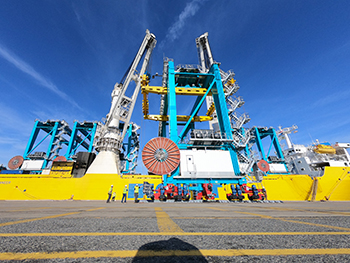Port expansion project nears finish line
Final cranes delivered to Norfolk International Terminals last week
Sydney Lake //May 19, 2020//
Port expansion project nears finish line
Final cranes delivered to Norfolk International Terminals last week
Sydney Lake //May 19, 2020//
The Port of Virginia announced Monday that the final group of stacking cranes needed to complete the $375 million crane addition portion of expansions at both the Norfolk International Terminals and Virginia International Gateway arrived May 14. The offloading process began the next day, Friday, May 15, and continued through the weekend.
During the past 27 months, 86 cranes have been delivered to the port to expand the port’s two main terminals, Norfolk International Terminals and Virginia International Gateway. The expansions at NIT and VIG — collectively totaling nearly $800 million, have also included an 800-foot extension of the berth at VIG, 19,600 feet of new railroad tracks and more room to stack and sort containers.
“We continue to mark milestones in the expansion of the Port of Virginia and this one signals that we are very close to completion of the work we started three years ago,” said John F. Reinhart, CEO and executive director of the Virginia Port Authority, who announced Tuesday that he will retire in 2021. “We have modernized our cargo handling capabilities at NIT and VIG, and significantly increased our operational efficiency and these cranes are a big part of the reason.”
In Nov. 2016, the port approved a $217 million contract for Finland-based Konecranes to build and deliver 86 cranes to the NIT and VIG. The order called for NIT to receive 60 cranes and VIG to receive 26, making it the largest one-time order for automated stacking cranes in industry history, said Port of Virginia spokesperson Joe Harris.

Konecranes sent the first six cranes in January 2018, creating a two-year delivery cycle. The process was repeated 14 times, with four deliveries made to VIG and 10 to NIT, including the final delivery last Thursday.
“The ability to receive the cranes at the terminals, do the final assembly and installation and then put them to work as soon as they were ready has been integral to the success of our overall expansion projects,” Reinhart said in a statement. “It allowed us to begin to move our customers’ cargo safer, swifter and more sustainably while demonstrating to the industry that we were bringing on the new capacity as soon as it was available. It is important to recognize Kone for working with us in developing the delivery schedule, and its dedication to ensuring that these cranes arrived on time and on budget.”
Konecranes manufactured the cranes, but partnered with Roanoke-based industrial electric and automation systems company Toshiba Mitsubishi-Electric Industrial Systems Corp. (TMEIC) to outfit the cranes with automation technology needed to drive the cranes. TMEIC produces power electronics, electric motors, drives and uninterruptible power supplies for industrial machinery.
It’s anticipated that the expansion project will be completed this fall after NIT construction is finished and the terminal receives two ship-to-shore cranes. Upon completion, the port will be able to process an additional 1 million containers — 600,000 at VIG and 400,000 at NIT.
“The maritime industry is facing unprecedented challenges, but there will be a recovery,” Reinhart said. “The Port of Virginia has the assets, equipment and capacity to be competitive and efficient while working with its customers and cargo owners to meet their needs.”
i

















